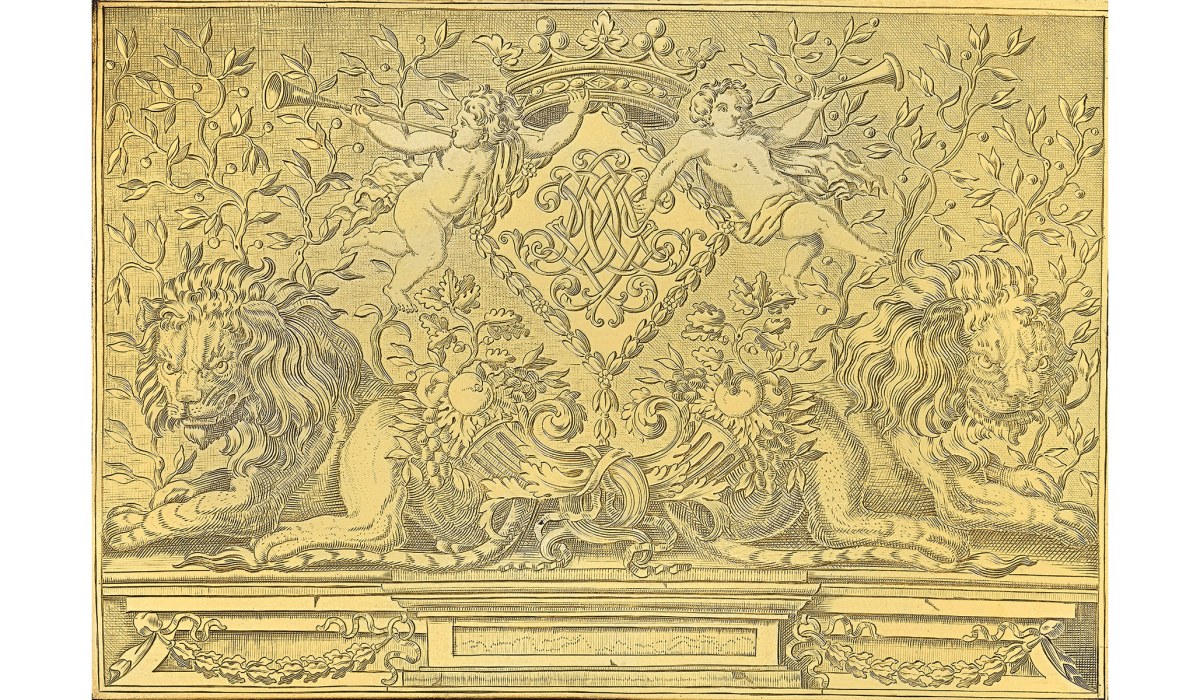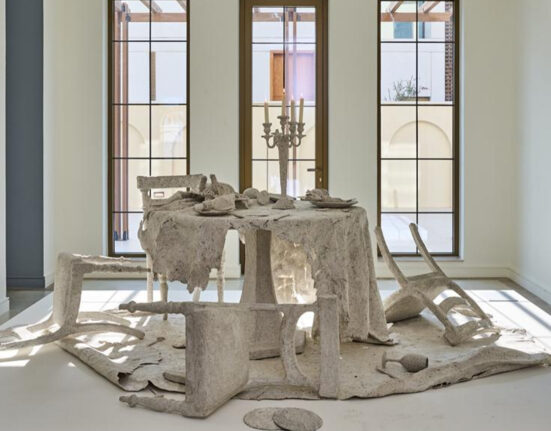NRPLUS MEMBER ARTICLE
{T}
he European Fine Art Fair (TEFAF) is one of my favorite events of the year. The art is uniformly good — every object is vetted independently for quality and authenticity — and most things are fresh to the market. Everything is museum-quality. The autumn version of TEFAF stresses, broadly speaking, design, and while there are paintings, and some very fine ones, sculpture, furniture, silver, and jewelry are the places to find hit after hit.
In this incarnation, the dealers aren’t there. No people-watching, either, and the quirks of the rich are always fun to see. I miss the dealers, all good-humored and doughty — they have to be since the in-person fairs run for days — and all connoisseurs. They’re enthusiasts, and you can’t fake that for an entire week, and they usually know more about their specialty than academics do. A professor will know an object’s place in the history of art. A dealer will know condition, provenance, rarity, as well as the art history I’d call salient rather than fancied, irrelevant, or minute — niches at which art historians excel.
In this online fair, each of around 280 dealers offers one object that expresses the very best of that dealer’s business. All the dealers have an international presence. All have done good scholarship and have sold to museums. TEFAF vets everyone to guarantees that no dealer is shady. TEFAF, as an entity, isn’t a business. It’s a foundation dedicated to upholding high standards in the art world.
I asked a curator friend what he thought of online fairs. He loves them. “I don’t have to talk to people,” he gushed. Most curators are introverts, which is one reason why they’re COVID’s most ardent, if nerdy, lockdown lovers. I’m dour, to be sure. Living in Vermont, we all sound and think like Calvin Coolidge after a while, but I do like the real thing, and I always learn from the banter of dealers and collectors. Alas, people are so frightened about travel and communal gatherings that it might take years to recover normal life. The hysteria peddlers have killed so much joy in the world.
Does the online TEFAF work? Yes. Each dealer has a page and provides basic information such as dimensions, provenance, and exhibition history. Most provide a good didactic description of the object. Some don’t, though, and TEFAF should require dealers to disclose the price and provide a narrative of, say, at least 1,000 words. Each dealer page has a link to his or her website.
It’s essential to see the objects, too, to hold them and compare them. At a fair with thousands of objects, I’d see a dozen Dutch still lifes, a hundred Impressionist paintings, endless old German things made of shells, and enough porcelain to feed tea to a battalion from the DAR. They’re an inevitable, organic process of comparing and contrasting from which “the best” always makes itself known. “Presence” is hard to convey, too, on a computer screen. Still, there’s no point in criticizing TEFAF. Everyone obviously put their best foot forward.

Last week, I wrote about Heracles killing the Hydra of Lerna, his second Labor. The multi-headed Hydra, spewing poison, fits the times. Dr. Geezer the Prosperity Slayer, his army of sycophant quacks, panic mongers, and safety freaks have insinuated themselves in every aspect of American life. They love the attention, and they don’t care that they’re killing culture. Slaying the Nemean Lion was Heracles’s first Labor. In strength, smarts, and perseverance, Heracles is hard to beat, but nowadays he’d work overtime. Just extirpating the full-mooners howling to lock us all up again — well, that’ll take the effort of all Twelve Labors.
Art Ancient in London sold a bit of inspiration: a very beautiful, 15-inch-high, first-century b.c. marble bust of the young Heracles wearing the lion’s hide. It was once part of a group of ancient sculptures of Greek and Roman gods displayed in the Duke of Sutherland’s garden. Sold with the rest of the contents of the Duke’s house in 1959, Heracles languished, unrecognized, in the garden of a Sussex home until its rediscovery last year.
Here, Heracles is young, battle-tested, and determined. No tweeting away the day for him, and he’s fighting angry lions, poisoned serpents, and crazy cattle, not microaggressions. The marble and carving are first-rate. Art Ancient made a virtual reconstruction of the Duke’s garden as part of its TEFAF pitch. At TEFAF, the bust sold quickly. Demand for Heracles, any Heracles, is high these days, and the supply of a first-rate Heracles like this is tiny.
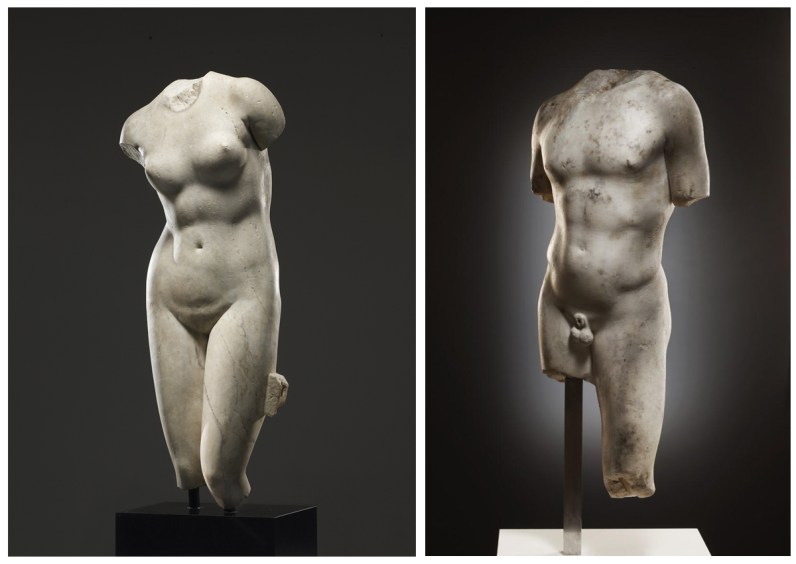
Right: Torso of an Ephebe or Young Athlete, marble, Greek, Hellenistic period, 3rd to 1st century B.C. (Photo courtesy Jean-David Chan, AG.)
Plektron Fine Arts in Zurich is offering an over-life-size torso of Aphrodite of Cnidus, from around a.d. 150. It’s a Roman version of the Aphrodite created by Praxiteles around 360 b.c. She’s the timeless nude, so well-known that it’s safe to say that all female nudes in art descend from her. It’s the perfect, sinuous, voluptuous form, with just a touch of reserve. It’s Carrara marble with light gray and brown veins. The torso has been in two distinguished collections. It’s offered for a price in the seven-figure range.
In the 18th century, the thing got a fake head, arms, and legs during a restoration. I saw photographs of it before the additions were stripped. Not bad, but the sculpture, restored to its as-found state, focuses us on that perfect serpentine line. I like the dealer, Ludovic Marock. He is an archeologist by training and knows his stuff.
Curators are, on one level, decorators, and the curator in me whispers, “What would be nicer than Aphrodite and the Ephebe offered by Jean-David Cahn, together?” The equally beautiful sculpture of a young athlete is about half the size, and it’s Greek, not Roman, and it’s from around 200 b.c. The torso’s elongated, which was Hellenistic style, and the surface isn’t heavily polished so there’s still a hint of tool marks. That’s Hellenistic, too. He’s an athlete, not a cover girl, so he has to look a little rough and tough. The white marble has black flecks in it, which emphasizes that he’s no Pajama Boy. He’s all lean muscle. The asking price is between 200,000 and 300,000 Swiss francs.
He’s got a bubble butt but, alas, the catalogue entry tells us that “the penis was originally attached separately.” Poor guy; it’s gone now. The high-school sophomore in me, nudged by my gay sensibility, came up with a dozen quips, each less subliminally pornographic than the last. The old cigarette-ad jingle “one silly millimeter longer” popped into my head, and, like any good Vermonter, barnyard humor wasn’t far.
The next object at TEFAF was a limestone Madonna of the Book, from the late 1470s, a sculpture of Mary and the Baby Jesus reading, offered by Cesati. There, I learned, the baby’s genitals were chiseled off at some point by prudes. I chuckled nervously and squirmed a little.
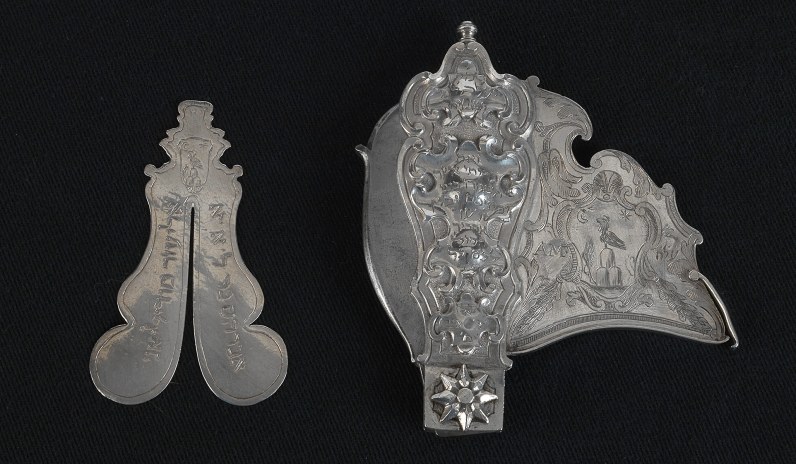
Then I saw the Avraham Modigliani silver circumcision set from 1761, offered by Alberto di Castro. “Ouch,” I said, suddenly sober. Back to aesthetics. The engraving is nice, with circumcision rites recited in Hebrew and quotes from Genesis and Deuteronomy as well as the Modigliani family crest. It’s Roman silver with Baroque design. The original owner, a rabbi, is an ancestor of the sculptor Modigliani. It’s exceedingly rare and from an Israeli collection. It’s €280,000. No Lorena Bobbitt jokes, please. This is a classy fair.
Speaking of silver, Pierre Harache made the silver gilt casket offered by S. J. Shrubsole in 1685 as part of a massive toilet set. English toilet sets are a fascinating niche in the genre of aristocratic silver. Silver for the dining room was what I call men’s silver. It conveyed status and wealth and was decorated with the family’s crest and arms, which develops from the man’s family. Then, dinner parties among the rich weren’t potluck. They were more like ceremonies meant to impress or to celebrate prestige guests, all bringing glory to the family name.
Toilet sets are women’s silver, as opposed to, obviously, circumcision sets. Usually wedding presents, they had as many as 40 pieces. Bottles held perfume, whisks applied and removed powder, candlesticks supplied lighting, and then there were caskets for the jewels, ribbons, and gloves for the day, all used to drag the lady of the house from sleep drunkenness and hair askew to a state of majesty.
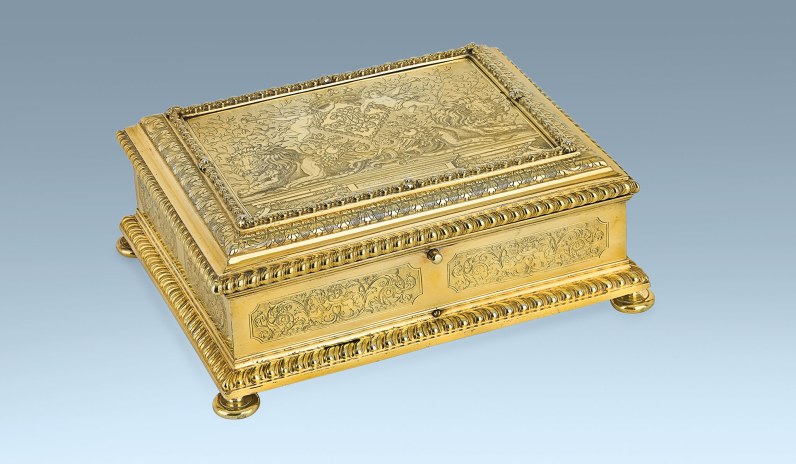
We don’t know the original owner since there are no arms, but Shrubsole is exactingly antiquarian in approach and can trace a silver needle in a haystack. It thinks that the casket belonged to one of three VIP aristocrats, based on the monogram of the original owner. We do know that by 1815 the Dowager Marchioness of Exeter owned it. Later, the Earl of Roseberry and the Countess of Halifax had it until 1960, when it was sold at Christie’s for £8,000, then a huge amount of money.
The theme of the splendid engraving is love and fertility, with putti symbolizing love, a cornucopia depicting plenty, and the flaming urn signaling immortality. Shrubsole has traced it to Blaise Gentot, a French engraver working in London. Harache was the first great French Protestant silver maker working in London after the expulsion of the Huguenots. Most of this grand toilet set is at Burghley House, the home of the Marquesses of Exeter. Somehow, along the line, the casket got separated, which often happens to sets in which the objects are many and small. The asking price is $500,000.
I haven’t focused on jewelry at art fairs, and it’s not because I don’t think it’s art. It is, and it can be great art, and then I look at it as sculpture. I’ll be honest. I think jewelry dealers do a quick appraisal and decide whether a visitor to their booth is a serious buyer or not. If not, the visitor gets the iceberg look and the Zamboni treatment. Brushed from the reality of their world, I tiptoe away. Often, jewelry dealers have guards posted. I think jewelry dealers tend to hate journalists, too, since next-to-none is an art historian. They’re lifestyle reporters who care about glitter and price.
I think most of the English and American jewelry dealers are nicer. In America, it’s hard to say who’s rich and who isn’t. In Europe and certainly in Hong Kong, Dubai, Tokyo, and Shanghai, it’s easy. In any event, I was inquiring online so, for all they knew, I could have been rich as Croesus. I was well treated even after the dealers learned I was from the scribbling class.
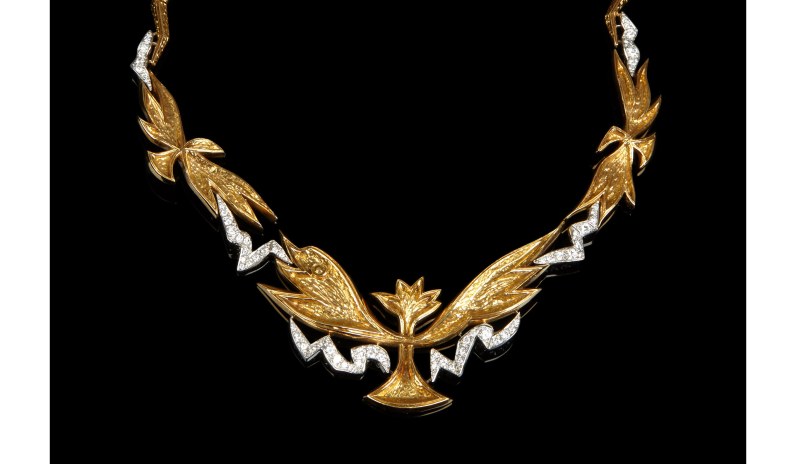
Didier, the London dealer, has a handsome, unique necklace designed by Georges Braque in 1961. Braque is a great artist and, with Picasso, invented Cubism around 1907. It’s made of brilliant cut diamonds and gold, fashioned in a bird motif inspired by Aeolus, never a god but the son of Poseidon and keeper of the winds. It’s a strong object meant for a woman — or man — of consequence. It’s $200,000.
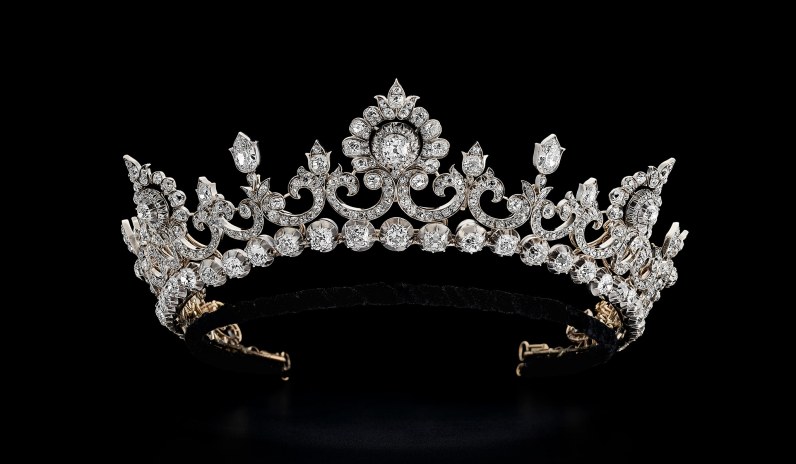
The Anglesey Tiara, made in 1890, was indeed owned and worn by a man: Henry Paget, the fifth Marquess of Anglesey. At 23, Paget inherited the title, a 30,000-acre estate, and an income of 12 million pounds a year, for all of which the exotic dancer, cross dresser, and spendaholic was unideally suited. He blasted through millions on things such as the conversion of the family home’s chapel into what he called the Gaiety Theater, where he acted and danced. He died in 1905 at 29, deeply in debt but much loved by his Welsh staff and neighbors.
After his death, the tiara adorned only the marchionesses of the household, who wore it to three coronations. It’s over 100 carats and sells for €750,000 at Hancocks in Mayfair, one of London’s, and Europe’s, best sellers of antique jewelry.
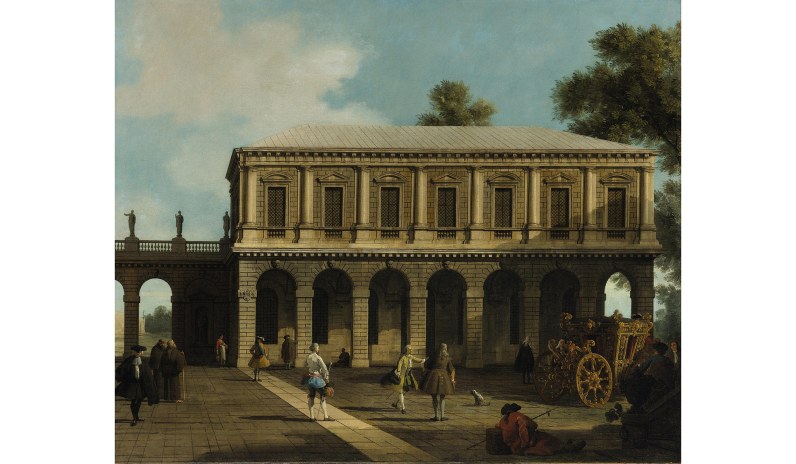
I saw some fantastic paintings. Canaletto’s Capriccio of the Public Prison of St. Mark is offered by Lampronti Gallery in London. It’s big, 41 by 50 inches, and it makes the statement that not all Canalettos are glittering, packed Venice water extravaganzas. It’s from around 1744 so, for Canaletto, it’s mid-career. It’s been in a private collection since 1964 and exhibited only one since then.
The prison is connected to the Doge’s Palace, by the Bridge of Sighs. It’s easy to miss since it’s an austere building and doesn’t fit the Venice mood of sparkling water and rococo abandon. Casanova escaped from it. It was also the headquarters of the Signori di Notte, the nighttime security police. It’s a strong Canaletto, not the touristy one, and without the regatta fanfare it’s easy to see what a good painter he was. It’s €4.5 million.
I didn’t know Walter Hampel, the Viennese Symbolist and contemporary of Klimt’s. His Henry Paget, the fifth Marquess of Anglesey, offered by Bernard Goldberg Fine Arts for $4 million, looks like a sublime example of German nature mysticism. It’s big, and the square format and dots of iridescent color must make it very striking. Klimt did square landscapes but none with a brilliant sunset or a mysterious figure. The painting was in the landmark Vienna 1900 show at MoMA in 1986, which boosts its value.
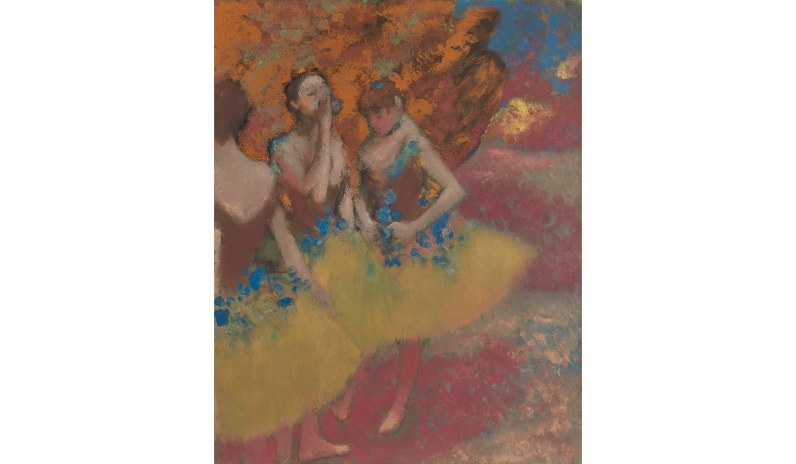
All of these objects are aesthetic triumphs in their own way, but I have to say that Degas’s Three Dancers in Yellow Skirts is, as the young say, epic. It’s offered by Hammer for “north of $37 million,” and it’s everything you’d want and need in a Degas. It’s from 1891. Degas is an enigmatic, tough artist. His dancers and bathers can be very lovely and graceful but sinister and awkward, too. He doesn’t have the ancestral authority of, say, Cézanne, but, like Whistler, Degas is a powerful though subtle influence in French art from Picasso’s earliest days until 1945. This painting, which Armand Hammer bought in the 1960s, is beautiful but cryptic, which keeps it alive and responsive. His work feels like an Old Master. I can’t say this is the best thing at TEFAF but it’s certainly the star of the show.

